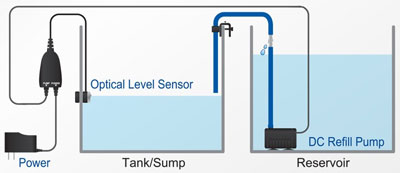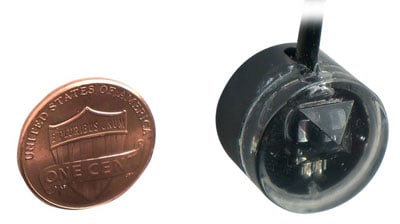Have you ever looked at an aquarium and the water level is 3/4 full or have been looking online or cruising the forums and keep coming across this ATO acronym? Have you decided you need to stop manually topping up your aquarium water?
Then the answer to all these is an Automatic Top Off System. I remember the first time I saw this system and I wondered how I had gone so long without one of these. ‘Game Changer’ is two words to describe these little guys!
Aquarium Automatic Top Off Systems (ATO’s) are a device that monitors and automatically adds freshwater to an aquarium to replace the lost water that the aquarium evaporates. Because of heat from lights, pumps, & the water temperature aquariums can evaporate up to several gallons of water each day.
An Automatic Top-Off System is one of the cheapest, yet best investments you can make to your aquarium and for not that much money they really save you a lot of work on a daily basis!
Read on to find out all about getting and setting up your own…
To help you follow and understand what an ATO system is you can check out a huge selection of ATO systems for all aquarium sizes Here at Amazon.com.
What Is An Aquarium Automatic Top Off System?
In any aquarium, whether it is a freshwater or a saltwater tank, your water will evaporate. Any time the surrounding air temperature is above 0°C/32°F water will begin to evaporate. The warmer the water gets, the faster it will evaporate. Add a breeze over the water surface, and it will evaporate even faster.
As water evaporates in an aquarium, the elements that don’t evaporate get left behind. This makes the concentration of these elements left in the water to become stronger.
For those of us with a saltwater aquarium, the evaporation causes our salinity to increase the more water we lose.
SALT DOES NOT EVAPORATE! ONLY THE WATER EVAPORATES!
Because the volume of salt remains the same, the salt-to-water ratio will rise, which if left unattended will cause distress and eventually death to the aquarium inhabitants.
To prevent this salt-to-water imbalance we must replace the water lost to evaporation with FRESH WATER.
This can be done by manually adding new water each day or install an Automatic Top Off system or ‘ATO’ as it’s commonly abbreviated to.
How Does An Aquarium ATO System Work?
In its basic form, an ATO works by sensing a drop in the aquarium water level and then inserts fresh water back into the tank until it is full again.

There are several ways that this can be accomplished:
- Electronic device with sensors and pumps
- Mechanical device with valves and timers
- A mixture of both devices
Let’s look at each type of system to help you understand the type of ATO you may wish to install on your aquarium and Trust Me, you will be installing one after you have manually topped up your tank every day for 2 weeks!
Electronic Aquarium Auto Top-Off Systems
There are some very, very good electronic ATO systems on the market today. They are manufactured by some other the most reputable aquarium manufacturers in the world and their reliability rate is incredibly good. This is good as an improperly working ATO will crash your tank and could flood your house, depending on how you have it set up.
The majority of the electronic systems available today monitor the water level using at least 2 sensors of some kind.
There will be an UPPER LIMIT sensor which will tell the unit to stop filling as the aquarium is now back to full.
There will be a LOWER LIMIT sensor that senses the water drop from evaporation, which then tells the device to start filling.
Additional items can be added to the units like a timer to ensure the unit will run for no longer than 10 minutes. A backup Upper Limit sensor to ensure your aquarium does not get overfilled and then flood your floor. An alarm to warn you of a fault.
Each manufacturer has its own unique system with pros and cons to both. There is also a large price range between the manufacturers so the choice really comes down to which system suits you better.
My Top Electronic ATO System Recommendations:
(Links to Amazon.com)
- XP Aqua Duetto – Dual Sensor and no moving parts
- Auto Aqua Smart ATO Micro – This unit is tiny and has no moving parts!
- JBJ Automatic Top Off – Use any pump you wish
- Tunze Osmolator Nano – Perfectly suited to Nano-Reefs with the pedigree of its older brother
Mechanical ATO Devices with Valves & Timers
This is a solution that appeals to the many, many DIY savvy reefers out there. The simple act of moving water from one vessel to another can be accomplished in many ways and the cost of doing so can vary over a huge range.
The mechanical devices and timers are a cheaper way of installing an ATO system and there are some kits available, or you can source the parts yourself and create your own DIY ATO.
The mechanical systems can be:-
- Gravity-fed to a float valve from a reservoir mounted higher up
- Pressure-fed straight from your RO/DI unit to a float valve
- Mechanical float switches connected to electrical relay and pump
These systems are by far the cheapest but you have to design in fail-safes to prevent failure and causing too much top off water to be put into your aquarium. A well-designed mechanical system can work very well, but for a beginner, I would stick to the Electronic Devices!
Some Mechanical Kits Available Are:
(Links to Amazon.com)
- Malida ATO Float Valve – As basic a device as you can buy
- Float Switch & Pump– Connect to a plug-in timer and you have a basic, but reliable ATO
Electronic & Mechanical Systems
This is the best for the DIY Reefer. This allows you the flexibility of cost with safety and reliability, BUT YOU HAVE TO KNOW WHAT YOU ARE DOING!
I created my own ATO built into my own Aquarium Controller. I used a mix of float switches, Electronic timers, and electronic solenoid valves to ensure my ATO works flawlessly every time.
Some people connect their ATO float valve to their RO/DI unit with a solenoid valve in between. This solenoid valve is then turned on by a plug-in timer to operate for 5 minutes, twice a day.
You could even place two solenoid valves inline in case one fails open!
The list is endless to a mix of electronic and mechanical ATO systems but as I said before if you are new to this just spend the few extra dollars and get a simple unit to install and setup from one of the recognized manufacturers.
This excellent video from MarineDepot will help you understand more…
Can I Use An Aquarium Automatic Top-Off Without A Sump?
You certainly can! In fact, some of the manufacturers have seen that customers are wanting to install ATO’s on sumpless tanks but they don’t want to see the huge sensor array slapped on the side of the glass.
The AutoAqua Smart ATO Micro (at Amazon.com) is a great example of that. Just look at the size of the sensor that sits on the side of the glass, it’s tiny!
The other great benefit to many, many of the ATO systems is you can install a 5 gallon bucket in the aquarium stand and feed the ATO. You would never know the system was installed! A 5 gallon bucket could last nano-tank weeks!
Precautions With Automatic Top-Off Systems
As with everything on an aquarium, you have to be careful and mindful of certain pitfalls. This entire website is dedicated to try and help prevent as many of them as possible.
If you watched the video you may have noticed some of the common installation pitfalls that can creep into a system. Below is a list of some of the more common things to watch out for with ATO’s:
Siphoning
This is when the ATO reservoir or water source is mounted higher than the aquarium or sump. Once the pump stops topping off, gravity will continue to pull the water through the pipe and into your system.
Install the reservoir lower or at the same height as the ATO dispensing pipe.
Loosely Installed Pipes and Sensors
A pipe falling out of the aquarium or sump will only lead to a wet floor, however, a sensor that falls off and activates could see a huge amount of freshwater dumped into your aquarium. Make sure ALL pipes, fittings, and sensors are securely installed.
Critters
Snails, shrimp, and crabs can play havoc on your float switches if they are in the same location as each other and the sensors are not guarded. A rogue critter can accidentally start or fail to shut off an ATO system and again, excess water gets dumped in!
Most kits now come with critter guards but keep them clean and working!
Stuck Float Switches
As with critters, a stuck float switch can crash your system. Get in the habit of each week give your float switches a clean and check for full travel and operation. I’ve had mine stick and only because of my regular maintenance did I find the problem before it was too late!
Empty Freshwater Reservoir
This is not as bad as dumping too much water in the aquarium, but make sure you check it often and keep it filled. Be very mindful to check it just before you leave to go on vacation. While you are away you could get an even bigger reservoir and stick it next to your stand so you know your ATO will not run out and burn the pump out from running dry!
Unlimited Water Supply
If you plumb your ATO into your RO/DI unit be aware that if it fails your water will not stop running. Not only will it crash your tank but it could also flood your house! If you do plumb it directly, make sure you have multiple levels of fail-safes in place to ensure your system is reliable and safe!
To Finish
ATO’s are one of the first jobs every person with an aquarium should automate. It is such an easy task to do and the $100 or so will be money well spent. There are many options to provide a solution to every budget and DIY skill level, and you will not regret setting up a system to keep your water volume and/or salinity bang on!
Further Reading
You may find the following articles helpful:


